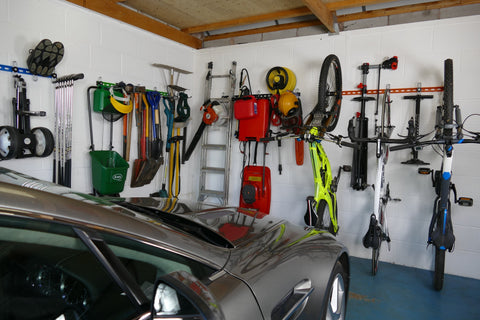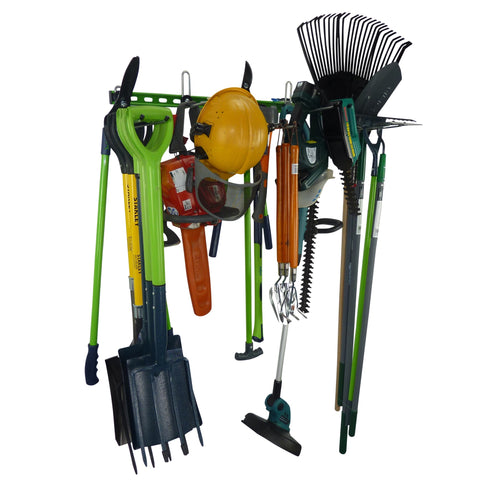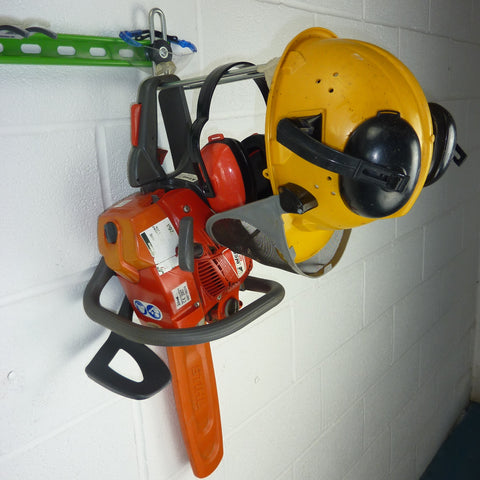The best way to store garden tools is to hang them on the wall. This might be inside a shed, in the garage wall or even on an outside wall or fence. With the right kind of hooks you can hang shovels or spades by the handles and longer items like rakes and brooms upside down by the head. If the hooks are long enough you might be able to hang several items on one hook which will save a lot of space. Using the walls to store smaller garden tools will keep the floor clear for bigger, heavier things like a lawnmower or garden roller.
Lets dive a bit deeper and look at some other questions people ask and try to shed a bit more light on the subject:
Can I store garden tools in a shed?
A shed is an excellent place to store garden tools. Sheds offer protection from the elements, such as rain, sun exposure, and extreme temperatures, which can damage tools over time. Sheds also provide dedicated space solely for storing gardening equipment, which helps keep tools organized and easily accessible. This can help to reduce clutter in other areas of your home or garage, freeing up space for other purposes.
Properly storing tools in a shed helps prolong their lifespan and maintains their functionality. Moreover, sheds can be customized with shelving, racks, and hooks to maximize storage efficiency and keep tools neatly arranged. Storing garden tools in a shed helps keep your outdoor space tidy, protects your investment in gardening equipment, and ensures tools are readily available when needed for gardening tasks.
What is the best way to store garden tools in a shed?
Garden tools can be stored in a shed by fixing separate hooks, or by simply knocking in some six inch nails, into the framework of the shed. Don't fix to the shed walls themselves as they are not thick enough and you will end up with screws or nails penetrating through the walls which is dangerous and will make the shed rot.

Darlac Tools | The Cutting Tool Experts
This approach is cheap and cheerful and will be fine if you just have a few tools to store. If you have a lot of tools you might find that the walls quickly fill up with tools and you run out of usable wall space. Having tools all around the perimeter of your shed will also limit what else you can store in the shed, like garden furniture or BBQs.
An alternative is to use wall mounted tool racks. These come in two basic designs; one made from wire mesh that hold tools one deep and another using longer garden tool hooks. Wire tool racks from the same problem as separate hooks - you quickly cover the walls in tools. They are also only suitable for fairly lightweight tools.

A garden tool rack with longer hooks means that you can store more tools in a smaller space. This saves wall space as well as leaving more usable floor space.
The GearHooks garden tool rack is a professional quality tool rack that will hold around 30 tools in just 1 metre of wall space. It fits quickly with just 3 bolts and comes with a lifetime warranty.
Can I store garden tools in a garage?
What is the best way to store garden tools in a garage?
The best way to store garden tools in a garage is on the walls as this keeps the floor clear for bigger things like a motorbike or a car. Garage walls are often breeze block or brick. Fixing individual garden tool hooks may need a couple of holes per hook. This requires a drill with a masonry bit and can be time consuming and fiddly.
A garden tool rack that holds a lot of tools on a rail with separate hooks is an easier option for garage walls. Some can be fitted with just a few fixings but these should be heavy duty as the weight of a lot of garden tools, especially petrol tools like a chain saw or hedge cutter, can be considerable.
Can I store garden tools outside?
Yes, it is possible to store garden tools outside, but it's not the most ideal option. When stored outdoors, garden tools are vulnerable to various environmental factors such as rain, snow, sun exposure, and fluctuating temperatures. Prolonged exposure to moisture can lead to rust and corrosion, compromising the integrity and functionality of the tools over time. UV radiation from the sun can cause materials like plastic and rubber to deteriorate, becoming brittle and prone to breakage. Storing tools outside increases the risk of theft or damage from environmental elements such as wind, animals, or vandalism.
While it may be convenient in some situations, storing garden tools outdoors requires careful maintenance and protection measures to ensure their longevity and effectiveness.

Photo by Ray Shrewsberry on Unsplash
If storing garden tools outside is unavoidable, it's essential to take precautions to protect them. Consider using weatherproof storage containers or covers to shield tools from rain and sun exposure. Regularly inspect and clean tools to remove any dirt or moisture and apply lubricants or rust inhibitors to prevent corrosion.
Storing tools indoors in a shed, garage, or other protected area is generally the best option for maintaining their longevity and functionality.
What is the best way to store garden tools outside?
If you have to store garden tools outside they should be stored under a rain cover, out of the sun and away from the prevailing wind. They should also be out of sight of passers by to avoid theft. Expensive petrol or electrical garden tools should be stored elsewhere if possible. Garden tools stored outside are more likely to rust and rot so metal surfaces should be coated and wooden handles should be treated. Old engine oil can be rubbed into metal and wooden surfaces and offers a good level of protection for free!
If you have to store tools outside then the hooks, or rack, you hang them on should be weatherproof and protected against corrosion.
All GearHooks garden tool racks are galvanised to prevent corrosion. In addition, the rails are powder coated. They are well suited to being used outside and are guaranteed for life wherever they are used.
What is the best way to store shovels or spades?
The best way to store shovels and spades is by hanging them vertically on a wall or from a rack in a shed, garage, or storage area. Hanging them vertically helps prevent them from leaning against each other or other objects, which can cause damage or deformation to the blades over time.
You can use specially designed tool racks with hooks or slots to securely hold shovels and spades in place. Alternatively, you can install hooks or nails on a sturdy wall and hang the tools by their handles. Make sure to leave enough space between each tool to prevent them from knocking into each other. This method not only keeps shovels and spades organized and easily accessible but also helps save space in your storage area.
What is the best way to store rakes and brooms?
Rakes and brooms should be hung upside down, by their heads, between two nails or double-pronged hooks. Alternatively, the handles can be slotted into holes or lengths of pipe. This method utilizes gravity to keep the tools securely in place while maximizing storage space. By storing them upside down, you prevent the tools from falling over and keep the bristles or blades off the ground, minimizing the risk of damage and prolonging their lifespan.
Using two nails or double-pronged hooks ensures stability and prevents the tools from slipping off. Additionally, this method allows for easy access to the handles, making it convenient to grab the tools when needed for gardening or cleaning tasks. Overall, hanging shovels and brooms upside down by their heads between two nails or double-pronged hooks is a practical and space-saving storage solution that helps keep your tools organized and in good condition.
What is the best way to store a chain saw?
What is the best way to store a strimmer or hedge cutter?

What is the best way to store heavy garden tools?
Storing heavy garden tools like a sledgehammer, axe, or maul requires careful consideration to ensure safety and prevent damage. Hanging the tools on a rack will keep the floor clear, away from pets and children, and prevent them falling over. However, great care should be taken when removing them from the rack to avoid injury.
Here's the best way to store them:
-
Secure storage area: Choose a designated storage area in a garage, shed, or workshop where the tools can be safely stored and easily accessed when needed.
-
Vertical storage: Store the tools vertically to prevent them from leaning or falling over. You can use a sturdy wall-mounted rack or tool organizer with hooks or slots designed to hold heavy tools securely in place.
-
Secure mounting: Ensure that the rack or organizer is securely mounted to a solid wall or structure to prevent it from falling off when loaded with heavy tools.
-
Individual compartments: If possible, store each tool in its own compartment, or held apart, to prevent them from coming into contact with each other, which can cause damage or dulling of the blades.
-
Protective coverings: Consider using protective coverings or sheaths to cover the blades of axes and log splitters to prevent accidental injuries and keep them in good condition.
-
Accessibility: Arrange the tools in a way that allows for easy access and retrieval when needed for gardening or other tasks. Keep frequently used tools at the front and less frequently used ones towards the back.
-
Regular maintenance: Periodically inspect the tools for signs of wear, damage, or rust, and address any issues promptly. Clean the tools after each use and apply a thin coat of lubricating oil to metal surfaces to prevent corrosion.
By following these guidelines, you can ensure that your heavy garden tools are safely and securely stored, ready for use whenever you need them.
The GearHooks garden tool rack is really heavy duty and designed for professional use as well as by keen gardeners. Each hook will support the weight of 4 or 5 heavy tools. The heaviest items should be stored closest to the wall.
How to store garden tools in a bin or tub
You can store garden tools in something standing on the floor like an old dustbin, a bucket or even an old trug. Tools may become tangled and smaller tools will drop to the bottom of the bin so whilst this is quick and cheap, it might become frustrating to use.

Begin by thoroughly cleaning the bin or tub to remove any dirt or debris. Next, arrange the tools neatly inside, placing larger items such as shovels and rakes along the bottom. Smaller hand tools can be stored in a smaller bin.
A top tip is to partly fill the bin with sand or gravel and push the tools into this. If you mix a little old engine oil into the sand it will help prevent rust. You could also use dividers or compartments within the bin to separate different types of tools and prevent them from tangling.
Lastly, store the bin in a dry and sheltered location, such as a garage or shed, to shield the tools from moisture and rust. With proper storage, your garden tools will remain easily accessible and in good condition for future use.
How to store garden tools using an old pallet
Repurposing an old pallet to store garden tools is a creative and practical solution and it saves money. Large tools can be slotted into the pallet and nails or screws can be added to hang smaller items. It's also important to fix the pallet securely to the wall, or add stabilisers to stop it falling over. Pallets are not treated so its best to keep the finished item in a shed or garage.

Pallet Garden Tool Storage | Heartwood Art
Here's how you can make and use it:
-
Preparation: Begin by thoroughly cleaning the pallet to remove any dirt, debris, or splinters. Sand down rough spots to make the surface smooth and safe to handle.
-
Mounting: Decide where you want to place the pallet—vertically against a wall or horizontally on the ground. Secure the pallet in place using screws or nails, ensuring it is stable and won't wobble.
-
Organizing: Arrange your garden tools on the pallet, placing larger items like shovels, rakes, and hoes, handle down in-between the top and bottom of the pallet.
-
Hanging: Utilize the slats of the pallet to hang small tools with handles. You can install hooks, nails, or brackets along the slats to hang tools securely.
-
Securing: Make sure each tool is securely fastened to the pallet to prevent them from falling off or getting damaged. You can use additional fasteners or straps to secure tools in place if needed.
-
Labeling: Consider labeling or marking each section of the pallet to indicate which tools belong where. This will help keep your storage system organized and make it easier to find specific tools when needed.
-
Maintenance: Regularly inspect the pallet and tools for any signs of wear, damage, or rust. Clean the tools after each use and apply lubricating oil to metal parts to prevent corrosion.
By following these steps, you can create a simple and efficient storage solution for your garden tools using an old pallet. It not only helps keep your tools organized and accessible but also adds a rustic touch to your garden or storage area.
How to store garden tools on a trolley
A garden tool storage trolley is a wheeled cart or trolley designed specifically for organizing and transporting garden tools and supplies. The big benefit is that you can move all your garden tools to where the work is. However, a fully loaded trolley might be heavy and moving it over wet grass, gravel or an uneven surface may be difficult.






